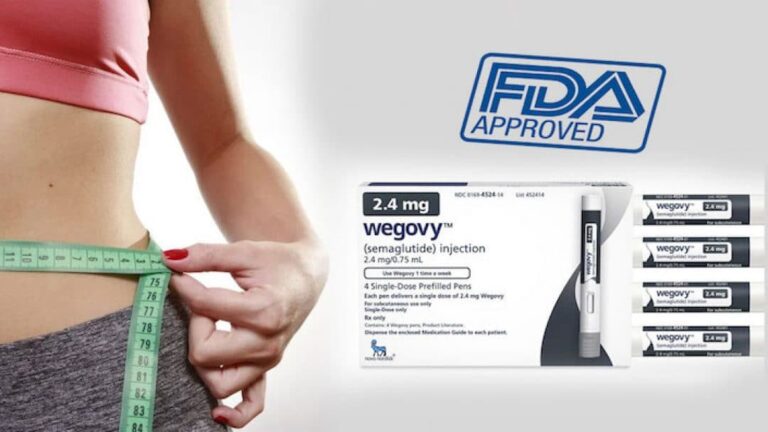
In recent years, weight loss injections have become a popular option for individuals looking to manage obesity and achieve significant weight loss. These injectable treatments are part of a broader strategy for weight reduction, often recommended for individuals struggling with diet and exercise alone. Weight loss injections like Wegovy, Saxenda, and Mounjaro offer new hope, targeting specific pathways in the body to reduce appetite and promote fat loss.
But with multiple options available, the question arises: What is the best injection for weight loss? This article will explore the most effective weight loss injections, their mechanisms, side effects, and how they can fit into a comprehensive weight management plan. We’ll also discuss the benefits and risks, helping you decide if these treatments are right for you.
How Do Weight Loss Injections Work?
Weight loss injections are medications that promote significant weight loss by targeting hormones responsible for hunger and metabolism. Most commonly, these injections are GLP-1 receptor agonists, a class of drugs that mimics the GLP-1 hormone, which helps regulate blood sugar, insulin, and appetite.
The most popular medications used in weight loss injections include:
- Wegovy: Contains semaglutide, a GLP-1 agonist that reduces hunger by slowing digestion.
- Saxenda: Includes liraglutide, which works similarly to semaglutide in promoting weight loss.
- Mounjaro features tripeptide, which acts on GLP-1 and GIP receptors to help regulate blood sugar and appetite.
These medications are primarily aimed at individuals with obesity or those with a BMI of 27 or higher, especially those who also have health complications like type 2 diabetes.
Top Weight Loss Injections on the Market
1. Wegovy (Semaglutide)
One of the most commonly prescribed weight loss injections, Wegovy (semaglutide) is a once-weekly injection that has been shown to help individuals lose an average of 15-20% of their initial body weight. It works by mimicking the GLP-1 hormone, slowing down digestion and making people feel full sooner.
In clinical trials, people who took Wegovy combined with diet and exercise lost significantly more weight than those who relied on diet alone. Wegovy is particularly beneficial for those with type 2 diabetes as it also helps regulate blood sugar levels.
- Approved for weight loss by the FDA.
- Often prescribed for adults with obesity or those struggling with excess body weight.
2. Saxenda (Liraglutide)
Saxenda is another popular weight loss injection, containing the active ingredient liraglutide. This drug requires daily injections and has been approved for chronic weight management in individuals with obesity or those who are overweight with conditions like type 2 diabetes. Like Wegovy, Saxenda works by reducing appetite and slowing gastric emptying.
Studies show that users of Saxenda can lose up to 10% of their initial body weight. It is also FDA-approved, making it a reliable choice for those who need a weight loss injection.
3. Mounjaro (Tirzepatide)
The newest addition to the weight loss injection market is Mounjaro, which contains tripeptide. This medication is unique because it works on both GLP-1 and GIP receptors, offering even better results for weight management and blood sugar control. Mounjaro is particularly effective for individuals with type 2 diabetes, helping them lose weight and maintain better glucose levels.
Mounjaro has been shown to help users lose up to 22.5% of their initial body weight, making it one of the most potent injections for weight reduction.
4. Ozempic
Like Wegovy, Ozempic contains semaglutide but is more commonly prescribed for individuals with type 2 diabetes to help manage blood sugar levels. However, it is often used off-label for weight loss because of its similar action in promoting weight reduction.
How Effective Are Weight Loss Injections?
The effectiveness of weight loss injections depends on a combination of the medication, the individual’s overall health, and lifestyle changes such as diet and exercise. Clinical studies have shown that these injections can help individuals achieve significant weight loss, often far exceeding the results from dieting alone.
For instance:
- Wegovy users have reported an average weight loss of 15% to 20% of their initial body weight.
- Saxenda has been shown to help people lose around 5% to 10% of their body weight.
- Mounjaro patients saw even more impressive results, with some losing up to 20% of their total body weight.
Weight loss injections are not meant to replace traditional methods but are most effective when combined with lifestyle changes, including a balanced diet and regular exercise.
How Long Do Results Last?
One of the major benefits of weight loss injections is their ability to sustain weight reduction over time. When combined with long-term diet and exercise, patients can maintain their weight loss and reduce the risk of regaining the weight they lost.
Side Effects of Weight Loss Injections
Like all medications, weight loss injections come with potential side effects. The most common side effects include:
- Nausea
- Vomiting
- Diarrhea
- Stomach discomfort
- Fatigue
While these side effects are usually mild and resolve over time, more serious side effects can occur. Serious side effects include pancreatitis, gallbladder problems, and thyroid issues. It’s important to monitor any adverse reactions and discuss them with your healthcare provider. Rare but serious side effects can also include kidney dysfunction and allergic reactions.
Patients considering weight loss injections should consult with their doctor to determine whether these treatments are suitable for their health conditions. Common side effects include nausea, which typically subsides after a few weeks of treatment.
Weight Loss Injection vs. Diet and Exercise:
While diet and exercise remain the standard approach for long-term weight management, weight loss injections can be a game-changer for people who have struggled to achieve results through traditional methods. These injections, when combined with a balanced treatment plan, lead to more effective weight loss and better overall health outcomes.
For example:
- People who rely solely on diet and exercise may lose 5-10% of their body weight over a year.
- Individuals who use Wegovy or Saxenda combined with diet and exercise can achieve greater weight loss (15-20%).
However, weight loss injections should not be seen as a magic bullet. They are most effective when paired with sustainable lifestyle changes, including dietary improvements and physical activity.
Who Is a Good Candidate for Weight Loss Injections?
These injections are often prescribed for adults who are obese or those who are overweight with a BMI of 27 or higher, especially if they have related health conditions such as type 2 diabetes or heart disease.
Weight loss injections are particularly beneficial for:
- People with type 2 diabetes.
- Individuals who have tried and failed to lose weight through traditional methods.
- Those seeking long-term weight management solutions.
Individuals should undergo a thorough medical evaluation before starting any weight loss injection regimen.
FDA-Approved Weight Loss Injections
In the U.S., several weight loss injections are FDA-approved, including:
- Wegovy (semaglutide)
- Saxenda (liraglutide)
- Mounjaro (tirzepatide)
These medications are thoroughly tested in clinical trials for weight loss and have demonstrated safety and efficacy in individuals with obesity or type 2 diabetes. When choosing an injection, it’s important to opt for FDA-approved treatments to ensure you’re using a reliable, effective product.
Insurance and Cost of Weight Loss Injections
The cost of weight loss injections can vary depending on the specific medication, dosage, and whether insurance covers the treatment. On average, Wegovy and Saxenda cost between $1,200 and $1,500 per month. However, some insurance plans may cover weight loss medications, making them more affordable for patients.
If insurance does not cover the cost, many pharmaceutical companies offer discount programs to help reduce expenses. Be sure to check with your insurance provider to see if they will cover weight loss drugs and discuss payment options with your healthcare provider.
Alternatives to Weight Loss Injections
While weight loss injections are effective, they’re not the only option for managing weight. Some alternative methods include:
- Prescription weight loss medications: Oral medications like Orlistat help reduce fat absorption in the digestive tract.
- Surgical options: For individuals with severe obesity, bariatric surgery offers long-term weight loss and health improvements.
- Diet and exercise: A structured plan focusing on calorie control and physical activity remains one of the most reliable ways to lose weight.
Conclusion
When it comes to choosing the best injection for weight loss, medications like Wegovy, Saxenda, and Mounjaro stand out as effective tools for achieving and maintaining weight reduction. These injections target specific mechanisms in the body, helping people who have struggled with traditional weight loss methods to achieve better results. However, it’s important to work closely with a healthcare provider to determine which option is best for your specific needs and to use these treatments alongside a comprehensive treatment plan that includes diet and exercise.
By understanding the options available and being proactive about your health, you can achieve long-lasting success in your weight loss journey.
















One Response